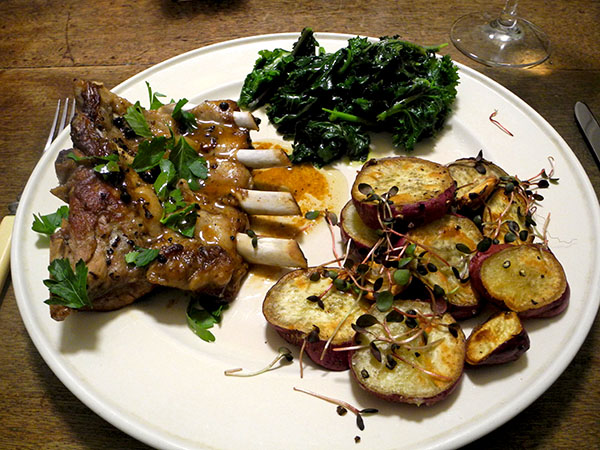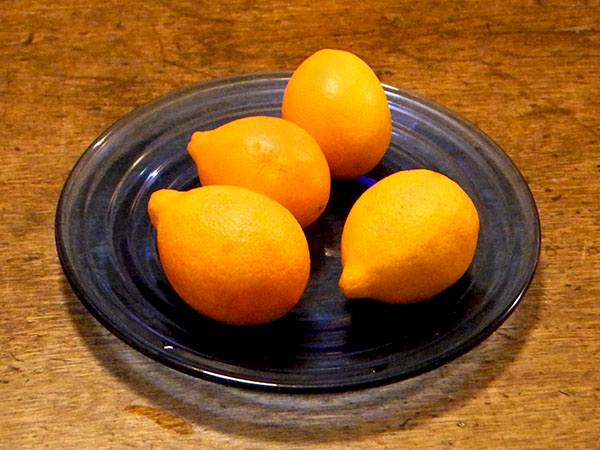
I don’t seem to have cooked pork ribs since I began this blog. I now realize that was a mistake.
The little package of ‘baby back ribs‘ lay on top of the farmer’s iced box of various pork cuts at the Union Square Greenmarket. I had already picked out 2 small pork chops, but the neat tidiness of the square package, and the realization that it had been something like, ..forever, since I’d cooked pork ribs, was enough to persuade me to go for them as well.
My only concern was their modest weight (a hair over one pound), but I knew that I could add at least 2 very good vegetables to fill out our plates.
I chose some red sweet potatoes,

and some beautiful kale.

Another question became critical only once I started to plan the meal. How was I going to cook the ribs? I had no experience of my own, and I had never paid enough attention to what my Mother did to make them one of our favorite meals in the middle of the last century.
The suggestions I saw on line seemed too southwest barbecue-y (not really my thing and not really an indoor stove thing). At first I thought there wasn’t anything useful in my paper files, but then Mark Bittman came to the rescue: I uncovered a 3-year-old New York Times clipping, ‘3 Ways to Do Ribs‘, where one of the recipes fit my parameters and looked very promising, for several reasons.
It was an excellent recipe; it was delicious, required few ingredients and relatively little attention, and it also allows for a number of variations.
- one 1-pound package of baby rack pork ribs (in 2 sections) from Flying Pigs Farm, browned for 5-10 minutes of so in a little olive oil inside a large, tin-lined copper pan over medium-high heat, meatiest side down, sprinkled with salt and freshly-ground black pepper, left more or less undisturbed, then turned and the other side browned, after which one large clove of garlic from John D Madura Farm, crushed, one large salted anchovy from Buon Italia, rinsed and filleted, and one crushed section of a dried orange-golden habanada pepper (my signature innovation for this recipe) were added and and stirred in for a minute, followed by one third of a cup of white wine (a California [Clarksburg] white, Karen Birmingham 2015 Pinot Grigio), any browned bits from the bottom of the pan scraped up, the wine brought to a simmer, the ribs covered and cooked until tender, for about an hour, basically unattended (in fact, I let the pan sit, covered, for another 15 minutes while the sweet potatoes finished in the oven, so, once again, let me say that this is a low-stress recipe), the ribs arranged on the 2 plates, some of the truly delicious juices poured on top, garnished with some chopped parsley from Whole Foods Market
- less than a pound of Japanese sweet potatoes from Race Farm, unpeeled, but washed thoroughly, cut into one-half-inch pieces, tossed in a bowl with olive oil, salt, pepper, and 3 garlic cloves from John D. Madura Farm, arranged on a large well-seasoned Pampered Chef unglazed ceramic oven pan, placing the garlic on the top of potato slices (a better idea would be to toss unpeeled garlic cloves into the bowl with the potatoes and seasonings), roasted for about 30 minutes, garnished with red wasabi micro radish from two Guys from Woodbridge
- Siberian kale from Tamarack Hollow Farm, washed, drained, briefly sautéed in olive oil in which 2 bruised and halved garlic cloves from John D. Madura Farm had first been allowed to sweat and begin to color, the greens seasoned with salt, pepper, a very small amount of crushed dried crushed dried Sicilian pepperoncino from Buon Italia, arranged on the plates and a little more olive oil drizzled on top
There was a small, very refreshing citrus dessert.
- two large (we used fruit knives and forks) hybrid Kumquats (I forgot to get the name) from Dean & DeLuca

- the wine during the main course was a California (Carneros) white, La Tapatia Chardonnay Carneros 2015
- the music was, from late in the afternoon until earlier in the evening, while the dinner was being prepared and cooking, Wagner’s ‘Parsifal’, Jaap van Zweden, directing the Netherlands Radio Philharmonic Orchestra, the Netherlands Radio Choir and the State Male Choir Latvija; and, during the meal itself, the same conductor and orchestra performing Bruckner’s Symphony No. 9